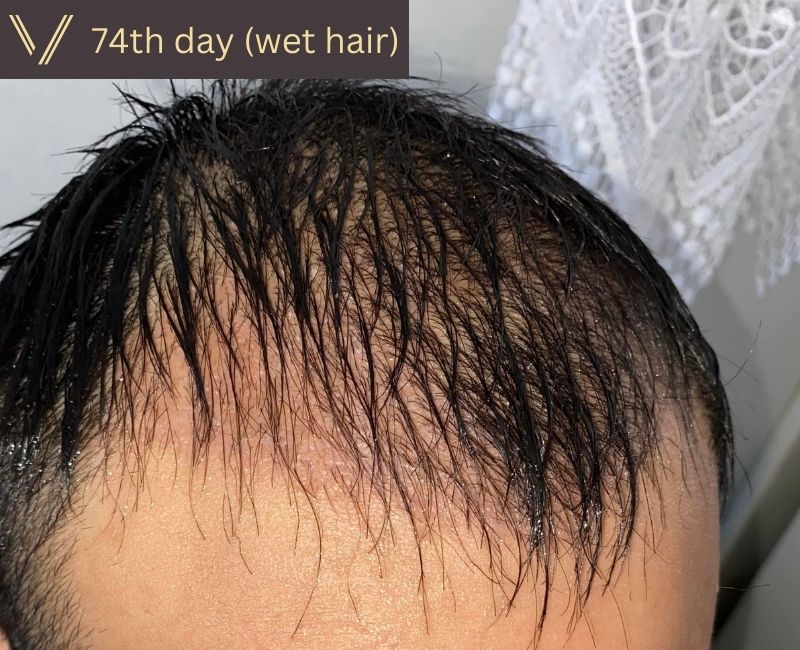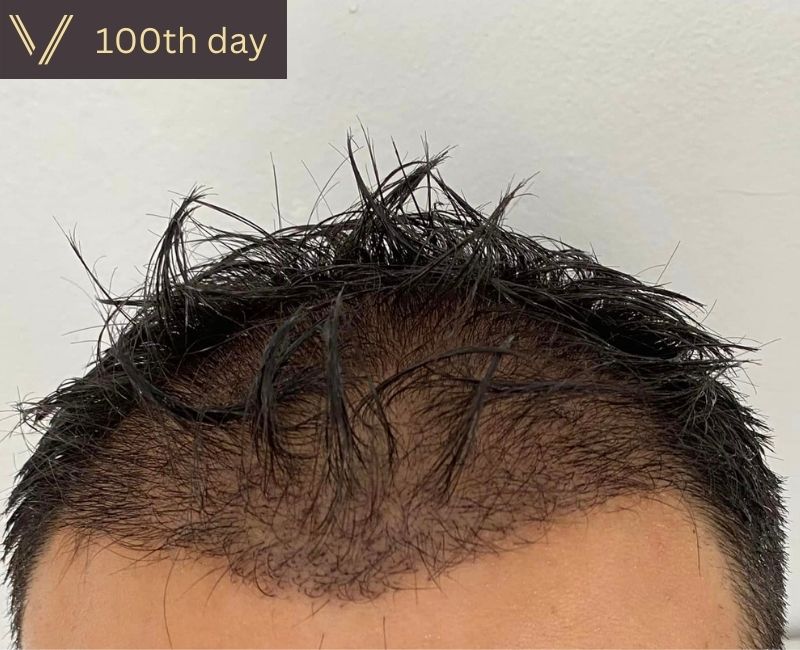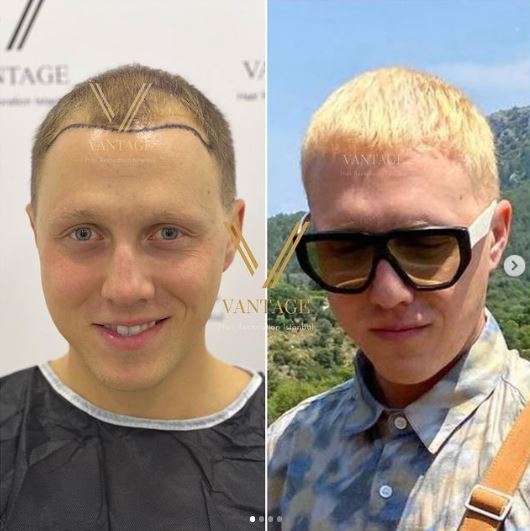
Hair Transplant Growth Timeline Journey
Before moving on to Hair Transplant Growth Timeline, let’s discuss some basic journey processes.
The hair transplant journey is one that requires patience. This is why many people who are considering a hair transplant are wondering about the growth timeline and recovery period. If you are also curious about what it takes to get that dream hair after a transplant operation, taking a close look at the timeline might be helpful.
Knowing the details of the recovery can help you decide whether you are up for starting this journey and how much time you should be investing.
If you consider that in the end hair transplant offers great permanent results, the recovery journey is worth going through. Here, let’s see what hair transplant recovery day by day looks like.

Day by Day Photos After Hair Transplantation
Right after your surgery, you will be wearing a light covering the protect the delicate areas. You can also notice some redness and swelling around the transplant area. It is important to be as careful as possible during the first 48 hours to make sure your grafts are settling and healing is started. Then we will start tracking the hair transplant progress closely starting from week 1.

Hair transplant Results Photo after 1 week (7-10 days)
After the first week, your head will get scabby but the redness will go down. Your scalp will be still healing, and you may see some hair growth, not even close to your final result, at this stage. You should not touch your newly placed grafts for the first 7 days. It may take up to 10 days for the hair graft anchoring process. You may experience symptoms such as mild swelling and numbness. These symptoms are expected to decrease day by day.
Week 1 aftercare
Because your scalp will still be healing from the transplant operation, it is crucial to be gentle with this area and not touch the scalp as much as possible. You can see some scabs forming which you should not pick at under any circumstances. Try to keep your head elevated to reduce swelling at this stage. Protect your scalp from any impact and sudden movement.

Hair transplant Results Photo after 2 weeks (14-18 days)
You should be cautious at this early stage after hair transplantation. Crossing the 14-day mark is a milestone and you’ll have made significant progress within 7 days after your hair restoration. You may observe some hair shedding from the recipient site, similar to your normal hair growth cycle. This phase signifies the formation of new hair in the follicles, which will soon begin to grow. Two weeks after the hair grafting procedure, you can resume your daily activities, but don’t pick any remaining scabs off.
After two weeks you can notice that the healing is much faster. You can sleep in a normal position but still pay attention to not rubbing on the transplanted area while sleeping. The swelling will start to go down and the scabs should start to fall. You may have itchiness. Make sure you get rid of your scabs in 10 days; your clinic will be assisting you in regards to this step.
Month by Month Photos After Hair Transplantation
After the first two weeks of rapid changes in your hair, you can start to track your progress for hair transplant growth month by month where you can see bigger changes. When observing the hair transplant growth timeline, you’ll notice rapid changes in the first two weeks, followed by a slower progression. Despite some patients believing there’s no growth several months after a hair transplant, this isn’t accurate. Hair growth continues gradually, albeit less visibly, during this period.

Hair transplant Results Photo after 1 month (30-35 days)
During the first month after a hair transplant, it’s crucial to take care as your hairline will undergo dramatic changes like the presence of scabs and crusts. After 1 month, newly transplanted hair follicles will have settled in, and the scar tissue will be healed. You can notice that most of the discomfort, sensitivity, and itchiness have eased. Moreover, you’ll experience relief from issues such as swelling, oozing, and bleeding.
You’ll probably begin to overcome the shock hair loss process, allowing the transplanted hairs to grow progressively day by day. However, shock hair loss may also start even about 1 month after the hair transplant in some patients. For this reason, it is very critical to learn what to expect during hair transplant recovery. Additionally, after a male hair loss treatment, some patients may still experience redness even after one month. Depending on their ages, some patients’ bodies tend to heal at a slower pace. So be patient and do mild exercises.

Hair transplant Results Photo after 2 months (50-60 days)
At the beginning of the second month, your hair will start to grow, but you will need to be patient to achieve the significant growth you want. After the hair transplant operation, you are still at the beginning of the healing and resting process.
At this stage, you may not see any significant hair growth yet, but you have stepped into a stage where the roots have settled in a healthier manner and have started to take root. The process of shedding the grafts may have been completed and the new hair growth cycle may have begun.
Around two months post-procedure, you can expect a noticeable decrease in redness and crusting at the recipient site, making the transplanted hair more visible. While the transplanted hair may still be short and thin, you’ll begin to observe some growth and early indications of the final outcome. You should continue to follow the postoperative care instructions provided by your surgeon.
Will there be shock loss in the donor area?
Usually, the transplant area is affected by shock loss. It is extremely uncommon to experience shock loss in the donor area.

How long does shock loss last after a hair transplant?
The shock loss phase on the recipient area can last up to 4 months, which you will see noticeable regrowth afterwards.

Hair transplant Results Photo after 3 months (90-100 days)
You can notice some hair growth after 3 months of hair transplant but you should not be expecting a uniform growth. Your newly transplanted hair will start to grow slowly and independently.
You can see your new hair growing but the new hairs will probably be transparent and thin. This is only because they are not yet mature. You should not panic. Hair transplantation is a process that requires patience. If you are patient, you will have dense hair when they mature and grow.
Throughout the three-month progress, you’ll observe the integration of blood supply, which is crucial for hair follicle growth and survival. The establishment of connections between blood vessels and transplanted grafts is essential. Additionally, regeneration of nerves in the recipient site is necessary to ensure sensory feedback, a process that can take several months to complete. Adopting a healthy lifestyle, which includes a balanced diet, regular physical activity and effective stress management, promotes both optimal hair growth and overall health.

Hair transplant Results Photo after 4 months (120-130 days)
By the time you reach the four-month mark, you will start seeing new hairs sprouting. However, it’s essential to remember that you’re still over 8 months away from witnessing the full outcome of your hair transplant. Keep in mind that these newly emerging hairs are still in their early stages of development.
Your hair continues to undergo growth, with a potential increase of up to 50%. During this phase, transplanted hairs thicken and mature further. It’s crucial to adhere to the post-operative instructions provided by your surgeon and attend follow-up appointments for guidance and to evaluate progress.
It’s completely normal for your newly transplanted hair to shed after the surgery. This shedding occurs because the transplanted follicles enter a resting phase called telogen. It is a natural part of the hair growth cycle. During this phase, the hairs disconnect from the follicles and remain at rest for about three months before naturally falling out. However, it’s important to remember that your new hair is already being formed within the follicles during this phase, signaling the start of your hair growth journey.
Will I see any results after 4 months?
Yes, the phase between 4 – 5 months is generally boosts the motivation of the patient as you will start noticing significant growth after 4 months. However, your hair may grow uneven or there could be areas with less density.

Hair transplant Results Photo after 5 months (150-160 days)
You may experience a hair burst phase, which means that new hair growth is rapid. Also, partly patchy growth can be seen, but this is very normal for the first growth. Your new hair will be thin, translucent and short. They may not yet be as dark or dense as your natural look. The growth will be approximately one centimeter per month.
Around month 5, there will be a noticeable increase in the number of hairs growing from your scalp. Over time, the hair strands will become thicker and can be styled in different directions. The hair will slowly look like your natural hair color and the growth rate will be about 30% by the end of the fifth month.
It is possible to experience hair loss for around 4 months, but not everybody does. Some patients may experience hair loss even in the 5th month, and it can cause acne on the scalp.

Hair transplant Results Photo after 6 months (170-190 days)
By the sixth month, you should begin to notice the first signs of growth, although the density may not yet meet your expectations. It’s important to remain patient, as it’s unrealistic to expect final outcomes before the twelfth month.
During this time, attending follow-up appointments is crucial. If you notice very minimal hair growth, it may indicate an unhealthy hair growth process. In such cases, the medical team may recommend Finasteride or similar medications. These medications have proven to be highly successful in reducing signs of male pattern baldness.
Several factors may impact the results of your hair transplant, so it’s essential to be mindful of certain practices. Be sure to brush your hair gently, avoid using razors or clippers on the treated area, and protect your scalp from sunlight and potentially harmful hair care products. These precautions can help ensure the success and longevity of your hair transplant results.
What should I do if there is no density 6 months after the hair transplant?
Usually, you should be able to see increased hair density after 6 months of your hair transplant. However, if you don’t see hair transplant progress after 6 months, it does not mean that you should be worried. You might have to wait for a little bit longer as the final result of the hair transplant sometimes becomes noticeable after 12-14 months of the surgery. You can consult with your surgeon to see if there is anything to be worried about.
Does hair transplant thicken after 6 months?
Hair transplant may start to thicken after 6 months. But it is important to note that the 6 months mark still can be a halfway through the hair growth journey.
I am text block. Click edit button to change this text. Lorem ipsum dolor sit amet, consectetur adipiscing elit. Ut elit tellus, luctus nec ullamcorper mattis, pulvinar dapibus leo.

FAQs about Hair Transplant Growth Timeline
How long is recovery after a hair transplant?
The initial recovery period after a hair transplant takes 10-14 days. However, your scalp will still continue healing after this point. In terms of seeing the final results, it will take up to one year.
How can I speed up hair growth after a hair transplant?
If you want a faster hair growth after a hair transplant, there are some things you can do that might help speed up the process. First, care to maintain healthy habits such as a balanced nutritious diet and avoiding smoking. Proper aftercare also has a great impact on hair growth after a transplant procedure. You can also try supplementary treatments such as minoxidil and platelet rich plasma. Both treatments are known to stimulate hair growth.
How do I know if my hair transplant failed?
Usually, it is not easy to know whether a hair transplant has gone wrong before the 12-month mark. However, patchy areas as well as infections or skin abnormalities can be concerning signs. If you are not sure about the success of your hair transplant, make sure to consult with your surgeon.
When can you get a 2nd hair transplant?
Yes, getting a second hair transplant is possible. Whether you are looking to further increase hair density or looking for a restorative transplant after an unsatisfactory hair transplant, you can consider a second hair transplant.
Do you wish to know more about the progress? Feel free to shoot any questions for our team of experts to answer via WhatsApp button on the bottom-left or our contact form. Who knows, maybe you path to a youthful look with higher confidence lays one click away.
Follow our Instagram account for updated before and after photos @vantage.hair






